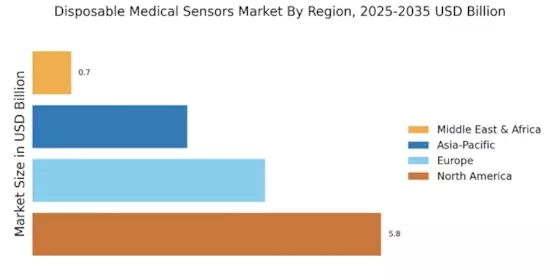Rising Prevalence of Chronic Diseases
The increasing prevalence of chronic diseases such as diabetes, cardiovascular disorders, and respiratory conditions is a primary driver for the Disposable Medical Sensors Market. As these conditions require continuous monitoring, the demand for disposable sensors that provide real-time data is surging. According to recent statistics, chronic diseases account for approximately 70% of all deaths worldwide, highlighting the urgent need for effective monitoring solutions. This trend is likely to propel the growth of the Disposable Medical Sensors Market, as healthcare providers seek efficient and cost-effective ways to manage patient health. Furthermore, the integration of these sensors into telehealth platforms enhances patient engagement and adherence to treatment plans, thereby potentially improving health outcomes.
Growing Focus on Preventive Healthcare
The growing focus on preventive healthcare is emerging as a significant driver for the Disposable Medical Sensors Market. As healthcare systems shift from reactive to proactive approaches, the demand for devices that facilitate early detection and continuous monitoring of health conditions is increasing. This trend is reflected in the rising investments in health technology, with expenditures on preventive care projected to reach unprecedented levels. The Disposable Medical Sensors Market stands to benefit from this shift, as these sensors enable healthcare providers to monitor patients remotely and intervene before conditions worsen. Moreover, the emphasis on reducing healthcare costs while improving patient outcomes aligns with the capabilities of disposable sensors, which are often more affordable and easier to use than traditional monitoring devices.
Technological Innovations in Sensor Design
Technological innovations in sensor design are significantly influencing the Disposable Medical Sensors Market. Advances in materials science and miniaturization techniques have led to the development of highly sensitive and accurate sensors that can be produced at lower costs. For instance, the introduction of flexible and biocompatible materials has enabled the creation of wearable sensors that can monitor vital signs continuously. The market for these innovative sensors is projected to grow at a compound annual growth rate of over 15% in the coming years. This growth is driven by the increasing demand for personalized healthcare solutions and the need for devices that can seamlessly integrate with mobile health applications. As a result, the Disposable Medical Sensors Market is poised for substantial expansion, driven by these technological advancements.
Increased Adoption of Home Healthcare Solutions
The increased adoption of home healthcare solutions is a pivotal driver for the Disposable Medical Sensors Market. As patients prefer receiving care in the comfort of their homes, the demand for portable and easy-to-use medical sensors is on the rise. This trend is supported by the growing aging population, which often requires ongoing health monitoring. The market for home healthcare devices is expected to grow significantly, with disposable sensors playing a crucial role in this transformation. These sensors not only provide convenience but also enhance patient autonomy and satisfaction. Furthermore, the integration of these devices with telehealth services allows for real-time data sharing with healthcare professionals, thereby improving the overall quality of care. Consequently, the Disposable Medical Sensors Market is likely to experience robust growth driven by this trend.
Regulatory Support for Innovative Medical Devices
Regulatory support for innovative medical devices is a key driver for the Disposable Medical Sensors Market. Governments and regulatory bodies are increasingly recognizing the importance of facilitating the approval process for new medical technologies. This support is evident in the streamlined pathways for the approval of disposable sensors, which are often classified as low-risk devices. Such regulatory frameworks encourage manufacturers to invest in research and development, leading to the introduction of advanced sensor technologies. The market is expected to benefit from this supportive environment, as it fosters innovation and accelerates the availability of new products. Additionally, the emphasis on patient safety and efficacy in regulatory guidelines ensures that only high-quality devices enter the market, further enhancing the credibility of the Disposable Medical Sensors Market.


















Leave a Comment